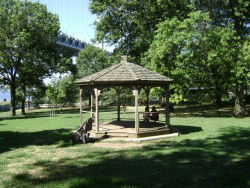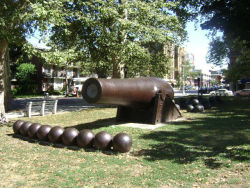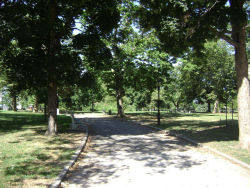John Paul Jones Park
View all monuments in NYC Parks, as well as temporary public art installations on our NYC Public Art Map and Guide.
John Paul Jones
| Dedicated: | October 27, 1980 |
| Location: | Ft. Hamilton Pkwy., 101 Street, Shore Pkwy. |
Artwork History
This park is named for American Patriot and Naval hero, John Paul Jones (1747-1792), who, through victorious leadership in the American Revolution, became known as “the father of the Navy.”
Born in Kirkcudbright, Scotland, the young apprentice John Paul went to sea at the age of 12 as a cabin boy. By age 19, he was first mate of a Jamaican slave ship. After murdering a mutinous crewman in 1773, he changed his name to John Paul Jones and fled to the American colonies. Enlisting in the newly established Continental Navy in 1775, Jones distinguished himself as captain of the sloop Providence, as First Lieutenant of the flagship Alfred and Captain of both the warships Ranger and Bonhomme Richard. On September 23, 1779 Jones’s ship slipped into the midst of a British mercantile convoy. In attacking the convoy’s escorts, the H.M.S. Serapis and the Countess of Scarborough, Jones’s smaller vessel suffered severe damage. His vessel afire and sinking, Jones refused the enemy’s demand for surrender, replying “I have not yet begun to fight.” Three hours later, the Serapis surrendered.
After this and other Revolutionary War victories, Jones received honors from all over the world, including a gold medal from the newly formed Continental Congress, and a gold-hilted sword from King Louis XVI who made him a chevalier of France.
Bound by Shore Road, Fourth Avenue, 101st Street, and Fort Hamilton Parkway, the City of Brooklyn acquired the property comprising this park between 1895 and 1897 as part of the proceedings for the construction of Shore Road, and transferred it directly to Parks. The United States Military presented the Civil War Memorial in 1900. The massive, black, 20” bore, Parrott cannon, founded in 1864, originally stood in Fort Pitt, Pennsylvania. Today it and the surrounding cannon balls dominate the landscape. The Revolutionary War Memorial consists of a bronze tablet on a granite boulder that Parks received, in 1916, from the Long Island Society of the Daughters of the American Revolution. In 1931, Parks received The Dover Patrol Naval War Memorial. The granite shaft by Sir Ashton Webb was a gift from England after World War I. These tributes to United States military history ushered in the 1969 name change to John Paul Jones Park.
In 1980, John Paul Jones Park acquired its most recent monument the 70 foot tall flag pole that once belonged to a Navy destroyer. At the base lies a plaque, which reads “in honor of John Paul Jones, the father of the Navy.”
Artwork Details
| Description: | Three flags on a stanchion, flagstaff |
| Materials: | Stone, bronze, concrete |
| Dimensions: | flagstaff was mast-uss daniel |
| Fabricator: | Alton Douglas, Lt (see memo) |
| Donor: | Committee for John Paul Jones |
Inscription
IN HONOR OF / JOHN PAUL JONES / FATHER OF THE U.S. NAVY / THISFLAGPOLE HAS BEEN REFABRICATED FROM THE / MAST OF THE U.S.S.
DANIEL NO. 335 BY LT. ALTON DOUGLAS / AND THE CREW OF THE U.S.S.
SEATTLE A.O.E.3, AND INSTALLED / ON THIS SITE WITH THE GENEROUS
ASSISTANCE OF INTERESTED CONTRACTORS. / MEMORIAL COMMITTEE/
EDWARD W. EVANS, PRESIDENT / ARTHUR J. O'BRIEN, VICE PRESIDENT/
HONORABLE ANGELO J. ARCULCO, CITY COUNCIL / MINORITY LEADER/
CHARLES J. HENRY, ENGINEER / ERECTED OCTOBER 27, 1980 / U.S.S.
SEATTLE / AOE-3 / (BRONZE SEAL)
Please note, the NAME field includes a primary designation as well as alternate namingsoften in common or popular usage. The DEDICATED field refers to the most recent dedication, most often, butnot necessarily the original dedication date. If the monument did not have a formal dedication, the yearlisted reflects the date of installation.
For more information, please contact Art & Antiquities at (212) 360-8163.
Check out your park's Vital Signs
Clean & Safe
Green & Resilient
Empowered & Engaged Users
Share your feedback or learn more about how this park is part of a
Vital Park System




